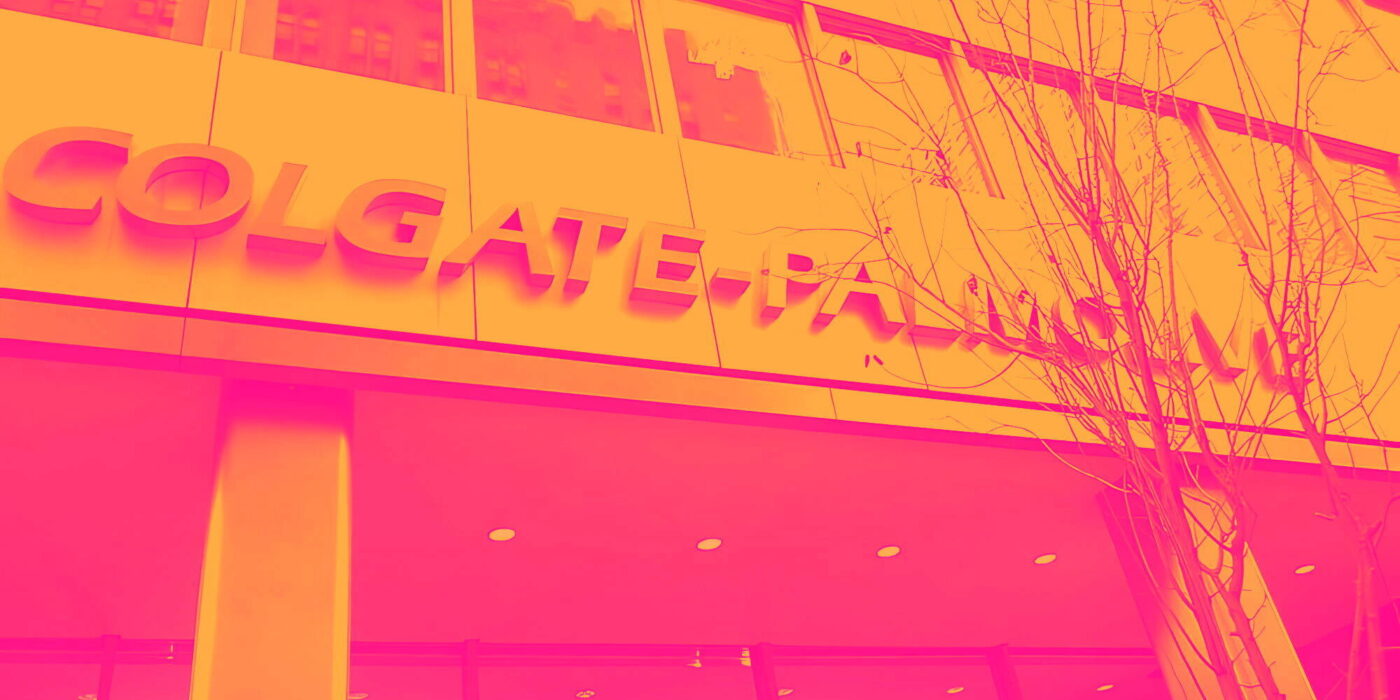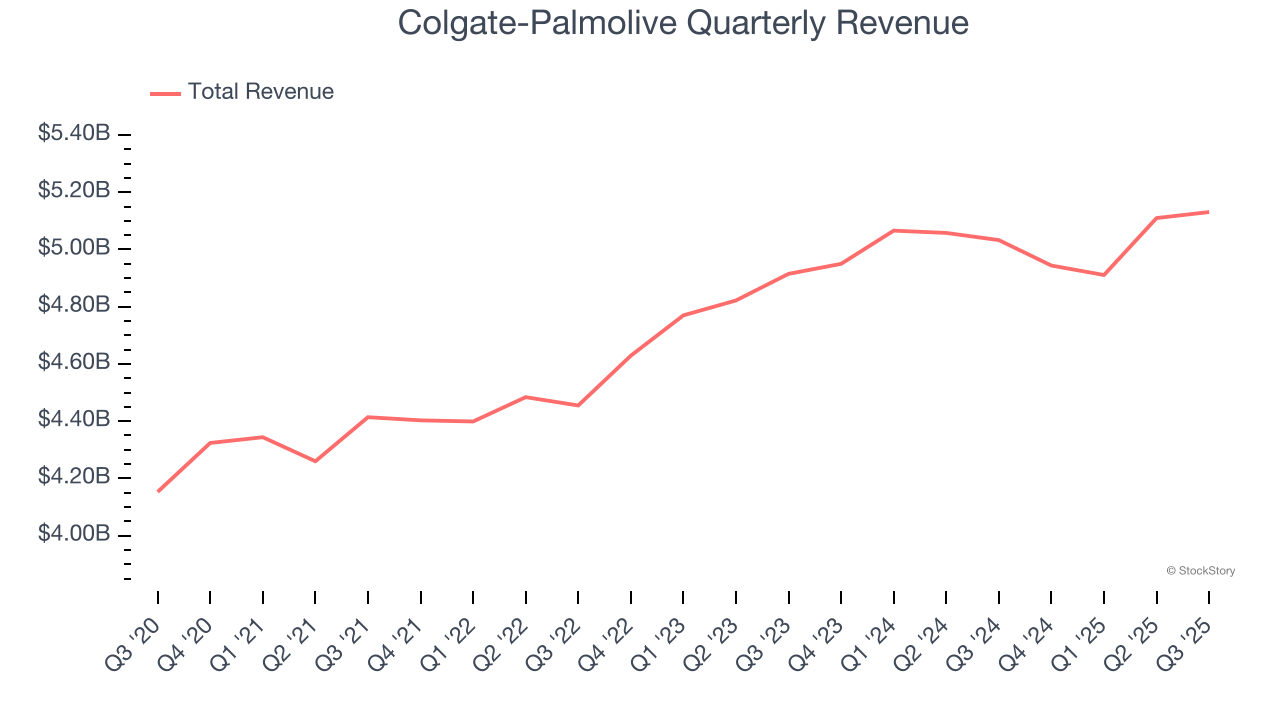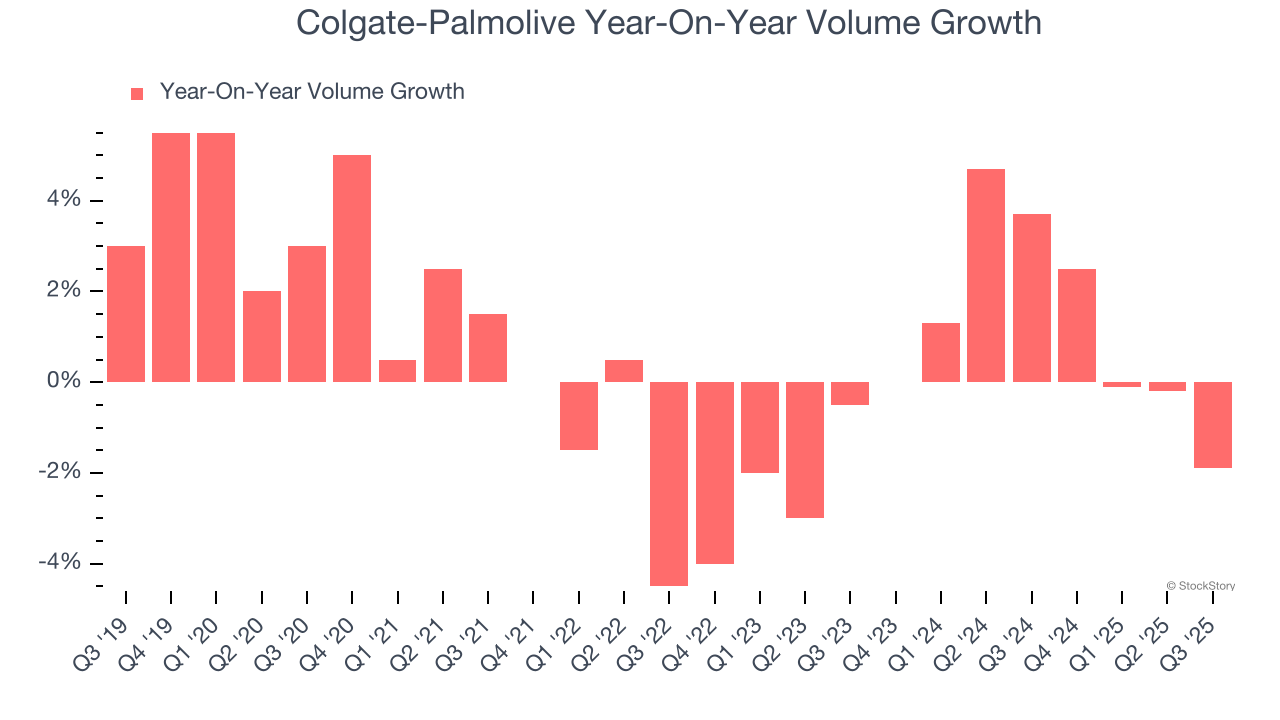
Consumer products company Colgate-Palmolive (NYSE:CL) met Wall Streets revenue expectations in Q3 CY2025, with sales up 1.9% year on year to $5.13 billion. Its non-GAAP profit of $0.91 per share was 2.4% above analysts’ consensus estimates.
Is now the time to buy Colgate-Palmolive? Find out by accessing our full research report, it’s free for active Edge members.
Colgate-Palmolive (CL) Q3 CY2025 Highlights:
- Revenue: $5.13 billion vs analyst estimates of $5.14 billion (1.9% year-on-year growth, in line)
- Adjusted EPS: $0.91 vs analyst estimates of $0.89 (2.4% beat)
- Adjusted EBITDA: $1.22 billion vs analyst estimates of $1.22 billion (23.7% margin, in line)
- Operating Margin: 20.6%, in line with the same quarter last year
- Free Cash Flow Margin: 21.6%, up from 20.5% in the same quarter last year
- Organic Revenue was flat year on year vs analyst estimates of 1.3% growth (89.3 basis point miss)
- Sales Volumes fell 1.9% year on year (3.7% in the same quarter last year)
- Market Capitalization: $61.84 billion
Colgate-Palmolive Company (NYSE:CL) today reported results for third quarter 2025. Noel Wallace, Chairman, President and Chief Executive Officer, commented on the Base Business third quarter results, “We are pleased to have delivered another quarter of net sales and organic sales growth, even in the face of slowing category growth in many markets and the negative impact from lower private label pet sales as we have exited that non-strategic business.
Company Overview
Formed after the 1928 combination between toothpaste maker Colgate and soap maker Palmolive-Peet, Colgate-Palmolive (NYSE:CL) is a consumer products company that focuses on personal, household, and pet products.
Revenue Growth
A company’s long-term performance is an indicator of its overall quality. Any business can put up a good quarter or two, but many enduring ones grow for years.
With $20.1 billion in revenue over the past 12 months, Colgate-Palmolive is one of the most widely recognized consumer staples companies. Its influence over consumers gives it negotiating leverage with distributors, enabling it to pick and choose where it sells its products (a luxury many don’t have). However, its scale is a double-edged sword because there are only a finite number of major retail partners, placing a ceiling on its growth. For Colgate-Palmolive to boost its sales, it likely needs to adjust its prices, launch new offerings, or lean into foreign markets.
As you can see below, Colgate-Palmolive’s sales grew at a tepid 4.2% compounded annual growth rate over the last three years, but to its credit, consumers bought more of its products.

This quarter, Colgate-Palmolive grew its revenue by 1.9% year on year, and its $5.13 billion of revenue was in line with Wall Street’s estimates.
Looking ahead, sell-side analysts expect revenue to grow 4.4% over the next 12 months, similar to its three-year rate. This projection is underwhelming and suggests its newer products will not lead to better top-line performance yet. At least the company is tracking well in other measures of financial health.
Today’s young investors won’t have read the timeless lessons in Gorilla Game: Picking Winners In High Technology because it was written more than 20 years ago when Microsoft and Apple were first establishing their supremacy. But if we apply the same principles, then enterprise software stocks leveraging their own generative AI capabilities may well be the Gorillas of the future. So, in that spirit, we are excited to present our Special Free Report on a profitable, fast-growing enterprise software stock that is already riding the automation wave and looking to catch the generative AI next.
Volume Growth
Revenue growth can be broken down into changes in price and volume (the number of units sold). While both are important, volume is the lifeblood of a successful staples business as there’s a ceiling to what consumers will pay for everyday goods; they can always trade down to non-branded products if the branded versions are too expensive.
To analyze whether Colgate-Palmolive generated its growth from changes in price or volume, we can compare its volume growth to its organic revenue growth, which excludes non-fundamental impacts on company financials like mergers and currency fluctuations.
Over the last two years, Colgate-Palmolive’s average quarterly volume growth was a healthy 1.2%. Even with this good performance, we can see that most of the company’s gains have come from price increases by looking at its 5.1% average organic revenue growth. The ability to sell more products while raising prices indicates that Colgate-Palmolive enjoys some degree of inelastic demand.

In Colgate-Palmolive’s Q3 2025, sales volumes dropped 1.9% year on year. This result was a reversal from its historical levels. A one quarter hiccup shouldn’t deter you from investing in a business, and we’ll be monitoring the company to see how things progress.
Key Takeaways from Colgate-Palmolive’s Q3 Results
We struggled to find many positives in these results. Its gross margin missed and its organic revenue fell slightly short of Wall Street’s estimates. EPS did manage to beat expectations, though. Overall, this quarter could have been better. The stock remained flat at $75.88 immediately after reporting.
Should you buy the stock or not? What happened in the latest quarter matters, but not as much as longer-term business quality and valuation, when deciding whether to invest in this stock. We cover that in our actionable full research report which you can read here, it’s free for active Edge members.
